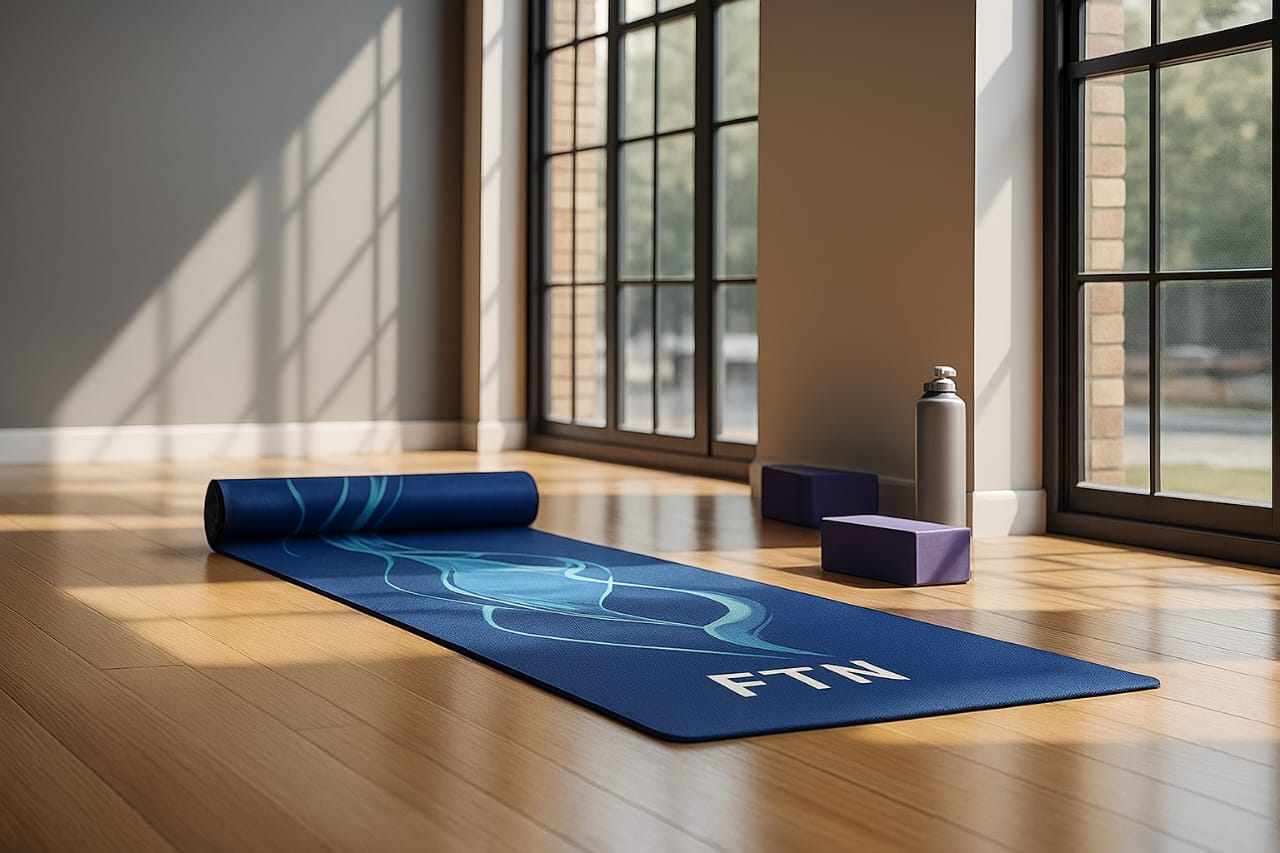🧘♀️ Introduction: Why Your Yoga Mat Matters More Than Ever in 2025
In recent years, yoga has evolved from a niche wellness activity into a global movement embraced by people of all ages and backgrounds. As more individuals prioritize physical and mental well-being, the yoga mat has become more than just an accessory—it’s an essential foundation for a safe, comfortable, and empowering practice.
A yoga mat serves several important roles. It offers grip and support, protects joints, and helps practitioners maintain balance and posture during challenging poses. With the market growing rapidly, yoga mats today are available in a wide variety of materials, textures, sizes, and features, making it essential to choose one that aligns with your body, practice style, and values—especially as sustainability and ergonomics continue to shape consumer choices in 2025.
🔒 Grip: The Cornerstone of a Safe Practice
Whether you’re a seasoned yogi or just starting your journey, grip is the most crucial factor to consider when buying a mat. A mat with good grip helps you maintain control in poses like Downward Dog or Warrior II, even when your hands get sweaty. This reduces the risk of slipping and injury, allowing you to focus fully on your breathing and alignment.
Mats made from natural rubber and thermoplastic elastomer (TPE) generally provide excellent traction. Some premium options come with textured surfaces or special coatings that increase friction. If you’re practicing hot yoga or doing high-intensity flows, look for a mat specifically designed for sweat-resistance and superior grip, ensuring that your movements are smooth and safe.
🛋️ Comfort and Cushioning: Support Your Body
Comfort is another key element to consider, especially if you spend a lot of time in seated or kneeling poses. A yoga mat’s thickness directly affects how much support it offers. Mats between 4mm and 6mm are ideal for most practitioners, as they provide a good balance between cushioning and stability.
For those with sensitive joints or who practice restorative yoga, a thicker mat (up to 8mm) can make a noticeable difference in comfort. However, overly thick mats may reduce your stability in balancing poses. High-density foam and eco-friendly materials like natural rubber or TPE offer both softness and resilience, supporting your body without feeling too squishy.
📏 Alignment Guides: Built-In Tools for Better Posture
Alignment cues on yoga mats—such as printed lines or geometric patterns—are becoming increasingly popular, especially among beginners. These subtle markings guide you in placing your hands and feet correctly, helping to build muscle memory and reduce the risk of misalignment.
Even experienced yogis can benefit from alignment aids. When attempting more complex poses or inversions, small visual markers can act as helpful reminders to adjust your posture or stance. In 2025, many premium yoga mats feature laser-etched alignment systems that don’t fade over time, combining form and function to support mindful movement.
🌱 Eco-Friendly Materials: Yoga with a Conscience
As environmental awareness continues to grow, more people are seeking yoga mats that align with their values. Traditional PVC mats may be affordable and durable, but they’re not biodegradable and can release harmful chemicals during production.
Sustainable options like cork, jute, recycled rubber, and organic cotton are becoming more accessible and affordable. These materials not only reduce environmental impact but also offer excellent grip, breathability, and comfort. When buying a yoga mat in 2025, consider certifications like OEKO-TEX or GOTS, which ensure the product meets certain environmental and health standards.
Investing in a sustainable mat supports both your practice and the planet—a win-win for conscious consumers.
🧳 Portability and Size: Matching Your Lifestyle
Do you practice at home, or are you always on the go? The size and weight of your yoga mat should match your lifestyle. Standard mats measure about 68 inches in length, but taller practitioners may prefer mats up to 72 or even 84 inches.
If you travel frequently or attend classes, look for lightweight mats that roll up easily and come with a carrying strap or bag. Travel-specific mats are often thinner (around 2mm) and foldable, making them convenient to pack. However, they may offer less cushioning, so you’ll need to balance portability with comfort depending on your needs.
💪 Durability: A Long-Term Investment
A high-quality yoga mat is a long-term investment in your health and practice. Cheaper mats made from low-density foam may wear out quickly—peeling, tearing, or losing their grip within a few months.
Durable mats, especially those made from dense rubber or high-grade TPE, can last for years with proper care. Look for mats that are resistant to sweat, UV rays, and moisture. Some brands even offer warranties or satisfaction guarantees, adding extra peace of mind to your purchase.
Cleaning your mat regularly and storing it properly—away from direct sunlight or extreme temperatures—will extend its lifespan and keep it fresh for daily use.
💲 Price Range: Finding the Right Value
Yoga mats range in price from under $30 to well over $150. While it might be tempting to buy the cheapest mat, it’s worth considering what you’re getting for your money.
Budget Mats ($20–$50): Good for beginners or occasional use. These usually offer basic comfort and grip but may lack durability.
Mid-Range Mats ($50–$100): Ideal for regular practitioners. Expect higher-quality materials, better grip, and added features like alignment guides.
Premium Mats ($100+): These often include advanced features, eco-friendly materials, and superior craftsmanship. Perfect for serious yogis who practice frequently.
Ultimately, the best yoga mat is one that matches your budget, supports your body, and aligns with your values.
🧘♂️ Mental Connection: Beyond Physical Benefits
Yoga isn’t just about flexibility and fitness—it’s a holistic practice that nurtures the mind, body, and spirit. The yoga mat becomes a sacred space where you can tune out distractions and tune into yourself. For many, unrolling the mat marks the beginning of a personal ritual of mindfulness, breathwork, and self-discovery.
Having a mat that feels right—whether it’s the texture, color, or eco-credentials—can deepen this connection. When your mat supports you physically and resonates with your inner values, your practice becomes more grounded and intentional.
✅ Final Thoughts: What to Look for When Buying a Yoga Mat in 2025
Before purchasing your next yoga mat, ask yourself:
Does it provide enough grip to prevent slipping?
Is the cushioning right for your joints and style of yoga?
Are there alignment aids to support your posture?
Is it made from eco-friendly or sustainable materials?
Will it last long enough to make it a worthwhile investment?
Is it the right size and weight for your routine?
Choosing the perfect yoga mat isn’t about getting the most expensive one—it’s about finding the one that helps you feel grounded, safe, and inspired to return to your practice again and again.
🧘♀️ Whether you’re flowing through Sun Salutations, holding a long meditation, or practicing gentle yin yoga, the right mat is your partner in every movement. In 2025, let your mat reflect who you are and where you’re going—on the mat and beyond.
“As an Amazon Associate I earn from qualifying purchases.”
Real Value the Video Adds to my Article
This video offers a hands-on comparison of top-tier yoga mats, evaluating essential features like grip under sweaty conditions, alignment aid clarity, cushioning levels, and sustainability credentials. It aligns perfectly with your sections—especially on grip, comfort, alignment guides, and eco-friendly materials—providing real-world visuals that reinforce your recommendations.
The video does an excellent job of balancing technical insight with user experience. Each mat’s surface texture and thickness are showcased in live practice settings, helping viewers visualize how it feels on their hands, feet, and knees. The reviewer explains materials clearly—especially those with alignment markers or eco-certifications—making it easy to see why certain mats (like Liforme and Jade Harmony) stand out.

